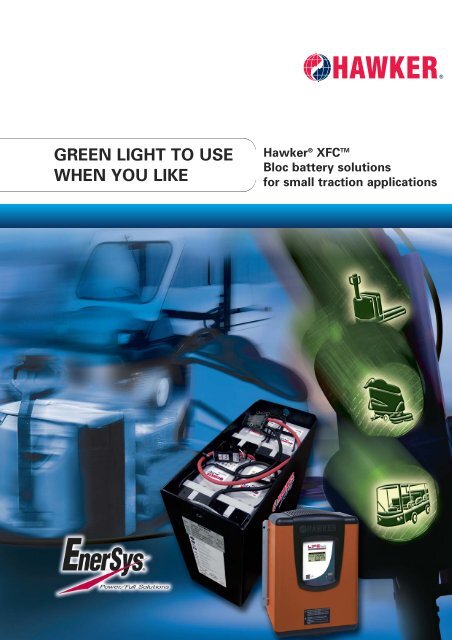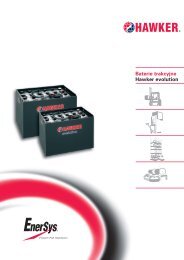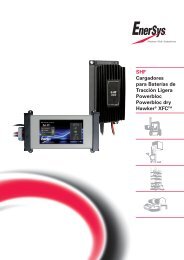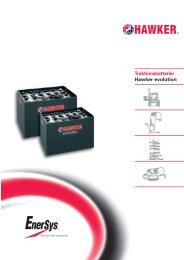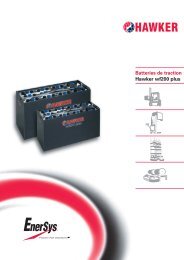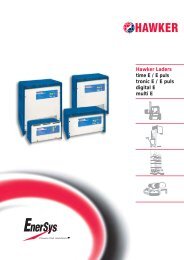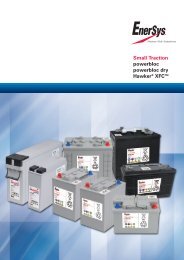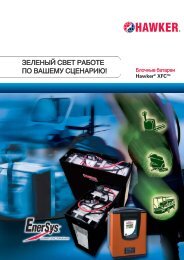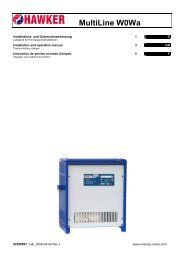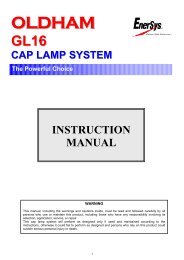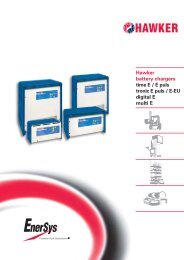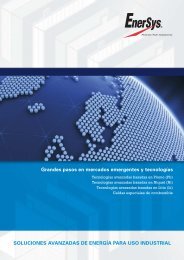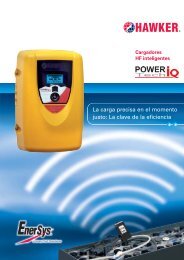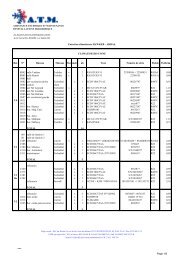16497 TH Hawker XFC gb - EnerSys-Hawker
16497 TH Hawker XFC gb - EnerSys-Hawker
16497 TH Hawker XFC gb - EnerSys-Hawker
You also want an ePaper? Increase the reach of your titles
YUMPU automatically turns print PDFs into web optimized ePapers that Google loves.
GREEN LIGHT TO USE<br />
WHEN YOU LIKE<br />
<strong>Hawker</strong> ® <strong>XFC</strong> TM<br />
Bloc battery solutions<br />
for small traction applications
CONTENTS<br />
Introduction..................................................................................................... 2<br />
Safety Precautions.......................................................................................... 2<br />
Recombination Technology........................................................................... 3<br />
Range Summary............................................................................................. 3<br />
Orientation.......................................................................................................4<br />
Battery Configurations................................................................................... 4<br />
Capacity........................................................................................................... 4<br />
Transportation................................................................................................. 4<br />
State of Charge............................................................................................... 4<br />
Storage – <strong>Hawker</strong> <strong>XFC</strong> blocs only................................................................. 4<br />
Storage – <strong>Hawker</strong> <strong>XFC</strong> blocs installed in equipment.................................. 5<br />
Commissioning............................................................................................... 5<br />
Operation......................................................................................................... 5<br />
Operating Temperature.................................................................................. 5<br />
Discharging..................................................................................................... 5<br />
Discharge Characteristics.............................................................................. 6<br />
Charging.........................................................................................................10<br />
Opportunity Charging...................................................................................11<br />
Cycle Life........................................................................................................11<br />
Disposal..........................................................................................................11<br />
Pay attention to the operating instructions and keep them<br />
close to the battery.<br />
Work on batteries must only be carried out by skilled<br />
personnel!<br />
Use protective glasses and wear safety clothing when<br />
working on batteries.<br />
Adhere to the current accident prevention rules in<br />
the country where the battery is used or EN 50272-3,<br />
EN 50110-1.<br />
No smoking!<br />
Do not expose batteries to naked flames, glowing embers<br />
or sparks, as it may cause the battery to explode<br />
Avoid sparks from cables or electrical apparatus as well<br />
as electrostatic discharges.<br />
Acid splashes into the eyes or on the skin must be<br />
washed immediately with an abundance of clean water.<br />
After abundant flushing consult a doctor immediately!<br />
Clothing contaminated by acid should be washed in water.<br />
2<br />
INTRODUCTION<br />
Since its introduction in the early 1990s, thin plate pure lead (TPPL)<br />
batteries have been established as a premium high performance battery<br />
suitable for a wide range of demanding applications. Today, the TPPL<br />
technology can be found in applications as diverse as emergency power,<br />
avionics, medical, military and consumer equipment.<br />
<strong>Hawker</strong> ® <strong>XFC</strong> TM batteries utilise the principles of advanced thin plate<br />
pure lead technology, to achieve exceptionally high performance,<br />
energy density and cycling capability. These characteristics make the<br />
<strong>Hawker</strong> <strong>XFC</strong> range ideal for use in motive power applications such as<br />
Floor-care, Pallet Trucks, AGV’s, Personnel Carriers and Utility Vehicles.<br />
This manual describes the <strong>Hawker</strong> <strong>XFC</strong> product range, physical<br />
characteristics and the basic information on storage operation and<br />
maintenance.<br />
SAFETY PRECAUTIONS<br />
Motive power batteries for small traction Valve Regulated Lead Acid<br />
(VRLA) monoblocs <strong>Hawker</strong> <strong>XFC</strong> series: TPPL technology.<br />
<strong>Hawker</strong> <strong>XFC</strong> batteries are designed using proven gas recombination<br />
technology, which removes the need for regular water addition. The use<br />
of gas recombination technology for lead acid batteries has completely<br />
changed the concept for motive power. This new technology gives the<br />
user greater freedom to use valve regulated lead acid batteries in a<br />
much wide range of applications.<br />
The minimal level of gas emissions from this type of battery allows<br />
the battery to be utilised in applications where previous restrictions<br />
might have been enforced. The <strong>Hawker</strong> <strong>XFC</strong> range is considered to be<br />
maintenance free, therefore there is no need for any routine water<br />
refilling to be carried out on the battery.<br />
Risk of explosion and fire<br />
Avoid short circuits: do not use non-insulated tools, do<br />
not place or drop metal objects on top of the battery.<br />
Remove rings, wristwatches and articles of clothing with<br />
metal parts that might come into contact with the battery<br />
terminals.<br />
Electrolyte is highly corrosive.<br />
In the normal operation of this battery, contact with acid<br />
isn’t possible. If the cell containers are damaged, the<br />
immobilised electrolyte (absorbed in the separator) is<br />
corrosive like liquid electrolyte.<br />
Batteries and monoblocs are heavy. Ensure secure<br />
installation! Use only suitable handling equipment.<br />
Lifting hooks must not damage the blocs, connectors or<br />
cables.<br />
Do not place batteries in direct sunlight without<br />
protection. Discharged batteries can freeze. For that<br />
reason, always store in a frost-free zone.<br />
Dangerous electrical voltage!<br />
Avoid short circuits: <strong>Hawker</strong> <strong>XFC</strong> batteries are capable<br />
of high short circuit currents.<br />
Caution - metal parts of the battery are always live:<br />
do not place tools or other objects on the battery!<br />
Pay attention to the hazards that can be caused by<br />
batteries<br />
Warning: Do not use any type of oil, organic solvent, alcohol, detergent, strong acid, strong alkali or petroleum based solvent or ammonia solution to<br />
clean the monoblocs. Such materials may cause permanent damage to the monobloc casing.
RECOMBINATION TECHNOLOGY<br />
How gas recombination works:<br />
When a charge current flows through a fully charged conventional lead<br />
acid cell, electrolysis of water occurs to produce hydrogen from the<br />
negative electrode and oxygen from the positive electrode. This means<br />
that water is lost from the cell and regular topping up is needed.<br />
However, evolution of oxygen gas and hydrogen gas does not occur<br />
simultaneously, because the efficiency of recharge of the positive<br />
electrode is not as good as the negative electrode. This means that<br />
oxygen is evolved from the positive plate before hydrogen is evolved<br />
from the negative plate.<br />
At the same time that oxygen is evolved from the positive electrode,<br />
a substantial amount of highly active spongy lead exists on the negative<br />
electrode before it commences hydrogen evolution.<br />
Therefore, provided oxygen can be transported to the negative electrode,<br />
conditions are ideal for a rapid reaction between lead and oxygen:<br />
i.e. This oxygen is electrochemically reduced on the negative electrode<br />
according to the following scheme,<br />
2e - + 2H + + 1 / 2 O 2 → H 2O<br />
and the final product is water…….<br />
The current flowing through the negative electrode drives this reaction<br />
instead of hydrogen generation which would occur in a flooded cell.<br />
This process is called gas recombination. If this process was 100%<br />
efficient no water would be lost from the cell. By careful design of the<br />
constituents within the cell, gas recombination up to 99% is achieved.<br />
Principle of the oxygen Reduction Cycle<br />
Figure 1 - Principle of the oxygen Reduction Cycle<br />
RANGE SUMMARY<br />
Available<br />
Table 1 – <strong>Hawker</strong> <strong>XFC</strong> specifications<br />
<strong>Hawker</strong> ® <strong>XFC</strong> TM<br />
3<br />
RECOMBINATION EFFICIENCY<br />
Recombination efficiency is determined under specific conditions by<br />
measuring the volume of hydrogen emitted from the battery and converting<br />
this into its ampere hour equivalent. This equivalent value is then<br />
subtracted from the total ampere hours taken by the battery during the<br />
test period, and the remainder is the battery’s recombination efficiency<br />
and is usually expressed as a percentage. As recombination is never<br />
100%, some hydrogen gas is emitted from <strong>Hawker</strong> ® <strong>XFC</strong> TM batteries<br />
through the self-regulating valve; the I gas value for this technology of<br />
battery is 1A/100 Ah C 5.<br />
RANGE SUMMARY<br />
(A) (B)<br />
(C) (D)<br />
Monobloc Nominal Nominal KW Dimensions Weight (1) No. of Terminal Terminal<br />
Type Voltage Capacity rating L W Box Terminal [Kg] cycles (2) Type Layout<br />
[V] [C 5] Height Height<br />
[mm] [mm] [mm] [mm]<br />
12<strong>XFC</strong>25 12 25 0.059 250 97 147 144 10 1200 M6 F (3) B<br />
12<strong>XFC</strong>35 12 35 0.085 250 97 197 194 13 1200 M6 F (3) B<br />
12<strong>XFC</strong>48 12 48 0.116 220 121 252 248 19 1200 M6 F (3) B<br />
12<strong>XFC</strong>58 12 58 0.14 280 97 264 248 19 1200 M8 F (3) C<br />
12<strong>XFC</strong>60 12 60 0.136 329 166 174 166 25 1200 M6 F (3) A<br />
12<strong>XFC</strong>82 12 82 0.197 395 105 264 248 28 1200 M8 F (4) D<br />
12<strong>XFC</strong>158 12 158 0.383 561 125 283 263 51 1200 M8 F (4) E<br />
12<strong>XFC</strong>177 12 177 0.433 561 125 317 297 58 1200 M8 F (4) E<br />
(1) Approximate (2) 60% Depth of discharge max (3) Can be fitted with SAE terminal (4 ) Can be fitted with M6 front terminal<br />
(E)
ORIENTATION<br />
<strong>Hawker</strong> ® <strong>XFC</strong> TM batteries can be mounted in any orientation except<br />
inverted.<br />
BATTERY CONFIGURATIONS<br />
<strong>Hawker</strong> <strong>XFC</strong> blocs may be configured into a battery comprising<br />
series/parallel arrays, with the maximum number of parallel strings<br />
limited to 2. It is paramount that the cable lengths within each string<br />
are equal.<br />
Only <strong>EnerSys</strong> approved components/ parts must be used in conjunction<br />
with <strong>Hawker</strong> <strong>XFC</strong> product.<br />
STATE OF CHARGE<br />
The open circuit voltage of the individual <strong>Hawker</strong> <strong>XFC</strong> bloc prior to<br />
installation can be used as an approximate guide to the state of charge<br />
(SOC) of the bloc. Figure 2 also shows the influence of storage temperature<br />
on the charge retention characteristics.<br />
OPEN CIRCUIT VOLTAGE<br />
13.20<br />
13.14<br />
13.08<br />
13.02<br />
12.96<br />
12.90<br />
12.84<br />
12.78<br />
12.72<br />
12.66<br />
12.60<br />
12.54<br />
12.48<br />
12.42<br />
12.36<br />
12.30<br />
12.24<br />
STORAGE – INDIVIDUAL HAWKER <strong>XFC</strong> BLOCS<br />
This data in this section only apply to batteries in storage not fitted to<br />
equipment.<br />
Batteries are dispatched from the manufacturer in a fully charged<br />
condition. The state of charge will decrease with storage. All batteries<br />
lose their stored energy when allowed to stand open-circuit, due to<br />
parasitic chemical reactions.<br />
Self- discharge is also strongly influenced by temperature; high temperatures<br />
greatly reduce storage life (fig.2 above). It is recommended that the<br />
fully charged battery should be stored in a cool dry place, ideally below<br />
20°C.<br />
STATE OF CHARGE AS A FUNCTION OF OPEN CIRCUIT VOLTAGE<br />
0 5 10 15 20<br />
MON<strong>TH</strong>S<br />
25 30 35 40<br />
––– 20°C ––– 30°C ––– 40°C<br />
Figure 2 – Open circuit voltages v state of charge<br />
4<br />
CAPACITY<br />
The capacity of the <strong>Hawker</strong> ® <strong>XFC</strong> TM series is rated in ampere-hours at the<br />
5 hour rate [AhC 5]. Table 2 provides available capacity as a function of<br />
discharge rate.<br />
Monobloc Nominal Capacity [Ah] 30°C<br />
Type C 1 C 3 C 5<br />
12<strong>XFC</strong>25 20.3 23.5 25<br />
12<strong>XFC</strong>35 28.9 33.6 35<br />
12<strong>XFC</strong>48 38.7 46 48<br />
12<strong>XFC</strong>58 45.8 55.8 58<br />
12<strong>XFC</strong>60 52.1 57.9 60<br />
12<strong>XFC</strong>82 65 76.5 82<br />
12<strong>XFC</strong>158 124 150.6 158<br />
12<strong>XFC</strong>177 138 168.5 177<br />
Table 2 – Capacity at different discharge rates<br />
TRANSPORTATION<br />
<strong>Hawker</strong> <strong>XFC</strong> batteries are classified as “non-spillable wet electric storage<br />
batteries” and may be shipped by air or ground transportation without<br />
restriction.<br />
<strong>Hawker</strong> <strong>XFC</strong> batteries are in compliance with requirements of:<br />
1) US Dept of Transportation - 49 CFR Section 173.159 para d<br />
2) ICAO/IATA Packing Instruction 872, Special Provision A67<br />
3) IMDG Class 8, UN ID 2800 special provisions 238<br />
4) ADR 2011 and RID 2011 Special Provisions 238, 295 and 598<br />
and are classified as Non-spillable and exempt from hazardous goods<br />
regulations when securely packed and protected against short circuits.<br />
100<br />
96<br />
92<br />
87<br />
83<br />
79<br />
74<br />
70<br />
65<br />
61<br />
57<br />
52<br />
48<br />
44<br />
39<br />
35<br />
The battery has a maximum inspection-free storage life of 2 years,<br />
if stored at or below 20°C, after which a refresh charge should be<br />
ad ministered. However, it is advisable to conduct an inspection and<br />
open circuit voltage check after 12 months. If the open circuit voltage<br />
falls below 12.6 volts the battery should be recharged using an<br />
approved <strong>EnerSys</strong> ® <strong>XFC</strong> charger.<br />
The battery may be stored for up to 5 years without degradation of<br />
performance provided that an open circuit voltage (OCV) check is<br />
conducted every 12 months. When stored in temperatures in excess<br />
of 30°C (86°F), the battery should be OCV checked every 6 months.<br />
STORAGE – HAWKER <strong>XFC</strong> BLOCS INSTALLED IN EQUIPMENT<br />
STATE OF CHARGE [%]
STORAGE – HAWKER <strong>XFC</strong> BLOCS INSTALLED IN EQUIPMENT<br />
Some equipment will continue to draw very low power loads from the<br />
battery when not in service resulting in battery discharge rate greater<br />
than shown in figure 2 and described in the previous section. Con -<br />
sequently all sources of electrical power drain must be removed from<br />
the battery whilst in transit, storage or extended periods of time out of<br />
service. This includes disconnecting the Wi-IQ (if fitted) from the battery.<br />
Failure to comply with the above will result in premature battery failure.<br />
Also refer to comments in opportunity charging section relating to short<br />
storage periods between equipment usage.<br />
COMMISSIONING<br />
The <strong>Hawker</strong> <strong>XFC</strong> series monoblocs are supplied in a charged condition.<br />
The battery should be inspected to ensure it is in perfect physical<br />
condition.<br />
Check:<br />
1. The battery cleanliness. Before installing, the battery compartment<br />
has to be cleaned.<br />
2. All cables and crimped connectors are in good condition to<br />
support high electrical currents.<br />
3. The battery and cables have a good contact to terminals and the<br />
polarity is correct. Otherwise the battery, vehicle or charger could<br />
be severely damaged.<br />
4. Ensure that all insulation covers are fitted correctly.<br />
5. It is extremely important to ensure the integrity of battery<br />
connections. Soldered connections are preferred for battery plugs<br />
and post clamps. If soldering is not possible, multi-point crimping<br />
must be used.<br />
NOTE: Flexible cable or braid connectors must be used for all monobloc<br />
connections. Appropriate fastener kits must be used and approved<br />
parts. These can be supplied in <strong>EnerSys</strong> approved accessory<br />
kits. Integral to the fasteners system is an appropriate locking<br />
washer – spring or flat washers must not be used.<br />
Connectors must be adequately fastened (see table 3) with the locking<br />
washer in place to maintain contact integrity when exposed to<br />
operational shock/vibrations.<br />
Monobloc Terminal torque [Nm] Terminal torque [Nm]<br />
Type Standard Terminal Terminal Adapter<br />
12<strong>XFC</strong>25<br />
12<strong>XFC</strong>35<br />
12<strong>XFC</strong>48<br />
M6 Female 6.8 Nm SAE 6.8 Nm<br />
12<strong>XFC</strong>60 M6 Female 6.8 Nm SAE 6.8 Nm<br />
12<strong>XFC</strong>58 Not Not<br />
12<strong>XFC</strong>82<br />
12<strong>XFC</strong>158<br />
M8 Female 9.0 Nm applicable applicable<br />
12<strong>XFC</strong>177 M8 Female 9.0 Nm M6 Front Terminal 9.0 Nm<br />
Table 3 – Torque settings<br />
Use special coding systems for maintenance free batteries for the<br />
charging plug-and-socket devices to prevent accidental connection to<br />
the wrong type of charger. Never directly connect an electrical appliance<br />
(for example: warning beacon) to a part of the battery. This could lead to<br />
an imbalance of the cells during the recharge, i.e. a loss of capacity, the<br />
risk of insufficient discharge time, damage to the cells and VOIDS <strong>TH</strong>E<br />
BATTERY WARRANTY.<br />
Charge the battery before commissioning. Only blocs with the same<br />
state of charge should be connected together.<br />
The specified torque loading for the bolts/screws of the end cables and<br />
connectors are detailed in the table 3.<br />
OPERATION<br />
EN 50272-3 “Safety requirements for secondary batteries and battery<br />
installations. Part 3 traction batteries” is applicable to this product range.<br />
The nominal operating temperature is 30°C. The optimum lifetime of the<br />
battery depends on the operating conditions (temperature and depth of<br />
discharge). The ambient temperature range of use for the battery is between<br />
+10°C and +45°C, outside of this range must be approved by the<br />
<strong>EnerSys</strong> Technical department. Optimal battery life<br />
is obtained with the battery at a temperature of 25-30°C Higher tempe -<br />
ratures shorten the life of the battery (according to IEC1431 technical<br />
report), lower temperatures reduce the available capacity. The upper<br />
temperature limit is 45°C and batteries should not be operated above<br />
5<br />
this temperature. The capacity of the battery changes with temperature<br />
and falls considerably under 0°C. The optimum lifetime of the battery<br />
depends on the operating conditions (moderate temperature and moderate<br />
depth of discharge – e.g. 40-60% C 5). It is mandatory that the depth<br />
of discharge does not exceed 80% of the nominal C 5 capacity. Figure 5<br />
and 6 show relationship between depth of discharge and cycle life.<br />
The battery obtains its full capacity after about 3 charging and<br />
discharging cycles.<br />
OPERATING TEMPERATURE<br />
<strong>Hawker</strong> ® <strong>XFC</strong> TM batteries and <strong>EnerSys</strong> ® approved chargers are<br />
designed for use within an ambient temperature range of +10°C to<br />
+45°C. For use outside this range, you should consult with <strong>EnerSys</strong><br />
APPLICATION ENGINEERING AU<strong>TH</strong>ORITY. Applications outside the<br />
recommended temperature range will be considered but it will be<br />
mandatory to use an <strong>EnerSys</strong> charger with communication capability<br />
(Life IQ TM or Lifeplus) and the battery must be equipped with Wi-IQ ®<br />
monitoring device to manage the charge profile in accordance with the<br />
battery temperature.<br />
DISCHARGING<br />
The valves on the top of the battery must not be sealed or covered.<br />
Electrical connections (e.g. plugs) must only be made or broken in the<br />
open circuit condition. Discharges over 80% of the rated capacity are<br />
categorised as deep discharges and are not acceptable as they reduce<br />
considerably the life expectancy of the battery. Discharged batteries<br />
MUST be recharged immediately and MUST not be left in a discharged<br />
condition.<br />
Note: The following statement only applies to partially discharged<br />
batteries.<br />
Discharged batteries can freeze.<br />
Limit the discharge to 80% DOD. The presence of a discharge limiter is<br />
mandatory and cut-off voltage must be set at the value detailed in table 4,<br />
when discharging with currents in the range of I 0.5 to I 5. At lower<br />
currents please seek advice from the <strong>EnerSys</strong> Application Engineering<br />
Authority.<br />
Table 4 - Cut-off voltage limits<br />
Cut-off voltage setting [Vpc]<br />
60% DOD 1.96 V<br />
80% DOD 1.92 V
DISCHARGE CHARCTERISTICS<br />
The following graphs show detailed discharge characteristic of the<br />
<strong>Hawker</strong> <strong>XFC</strong> range to an end point voltage of 1.75Vpc @ 30°C.<br />
CURRENT [Amps]<br />
CURRENT [Amps]<br />
12<strong>XFC</strong>25 PERFORMANCE DATA @ 30°C<br />
TIME [Hours to EPV 1.75 Vpc]<br />
Discharge rate [hr] 0.5 1 3 5 8 10 20<br />
Constant current Discharge [A] 34.7 19.9 7.76 4.95 3.21 2.67 1.48<br />
12<strong>XFC</strong>35 PERFORMANCE DATA @ 30°C<br />
TIME [Hours to EPV 1.75 Vpc]<br />
Discharge rate [hr] 0.5 1 3 5 8 10 20<br />
Constant current Discharge [A] 48.8 29.3 11.1 7.01 4.65 3.82 2.08<br />
6
CURRENT [Amps]<br />
CURRENT [Amps]<br />
12<strong>XFC</strong>48 PERFORMANCE DATA @ 30°C<br />
TIME [Hours to EPV 1.75 Vpc]<br />
Discharge rate [hr] 0.5 1 3 5 8 10 20<br />
Constant current Discharge [A] 64.0 37.6 15.1 9.63 6.31 5.14 2.82<br />
12<strong>XFC</strong>58 PERFORMANCE DATA @ 30°C<br />
TIME [Hours to EPV 1.75 Vpc]<br />
Discharge rate [hr] 0.5 1 3 5 8 10 20<br />
Constant current Discharge [A] 80.7 47.4 18.5 11.7 7.59 6.18 3.17<br />
7
CURRENT [Amps]<br />
CURRENT [Amps]<br />
12<strong>XFC</strong>60 PERFORMANCE DATA @ 30°C<br />
TIME [Hours to EPV 1.75 Vpc]<br />
Discharge rate [hr] 0.5 1 3 5 8 10 20<br />
Constant current Discharge [A] 88.0 50.3 19.1 11.9 7.68 6.23 3.26<br />
12<strong>XFC</strong>82 PERFORMANCE DATA @ 30°C<br />
TIME [Hours to EPV 1.75 Vpc]<br />
Discharge rate [hr] 0.5 1 3 5 8 10 20<br />
Constant current Discharge [A] 105.0 62.7 25.4 16.3 11.2 9.21 5.09<br />
8
CURRENT [Amps]<br />
12<strong>XFC</strong>158 PERFORMANCE DATA @ 30°C<br />
TIME [Hours to EPV 1.75 Vpc]<br />
Discharge rate [hr] 0.5 1 3 5 8 10 20<br />
Constant current Discharge [A] 196.1 120.0 49.5 31.8 21.1 17.2 9.35<br />
CURRENT [Amps]<br />
12<strong>XFC</strong>177 PERFORMANCE DATA @ 30°C<br />
TIME [Hours to EPV 1.75 Vpc]<br />
Discharge rate [hr] 0.5 1 3 5 8 10 20<br />
Constant current Discharge [A] 217.9 133.5 55.4 35.6 23.6 19.3 10.5<br />
9
CHARGING<br />
Charging the <strong>Hawker</strong> ® <strong>XFC</strong> TM batteries correctly is a critical factor to its<br />
life expectancy and performance, failure to do so will result in premature<br />
failure. To ensure that the <strong>Hawker</strong> <strong>XFC</strong> batteries are correctly charged,<br />
<strong>EnerSys</strong> ® has developed a fast charge algorithm for cyclic applications to<br />
rapidly and safely charge this technology of batteries. <strong>EnerSys</strong> have a<br />
full range of chargers available that can be purchased to be used with<br />
your <strong>Hawker</strong> <strong>XFC</strong> battery.<br />
TIME [HRS]<br />
Figure 3 – Recharge time – return 80% of discharged Ah’s<br />
As an example, consider a 100Ah battery discharged by 60Ah (to 60%<br />
Depth of Discharge), leaving residual capacity of 40Ah. 48Ah will be<br />
returned after 0.8hrs of charge with inrush current 0.6C5A. Battery<br />
state of charge after 0.8 hours will be approximately 86% as the recharge<br />
process is not 100% efficient.<br />
TIME [HRS]<br />
1.8<br />
1.6<br />
1.4<br />
1.2<br />
1<br />
0.8<br />
0.6<br />
0.4<br />
0.2<br />
0<br />
3.5<br />
3<br />
2.5<br />
2<br />
1.5<br />
1<br />
0.5<br />
Figure 4 – Recharge time – return 100% of discharged Ah’s<br />
Note:<br />
<strong>Hawker</strong> ® <strong>XFC</strong> TM batteries are designed to be charged with charging rates<br />
in range 0.4C 5 to 0.7C 5. Charging at rates outside this range can affect<br />
the performance and life expectancy of the battery. Contact <strong>EnerSys</strong> ®<br />
before using rates outside this range.<br />
% DEP<strong>TH</strong> OF DISCHARGE<br />
10<br />
Charging must only be carried out where adequate ventilation is<br />
available and must not be carried out in confined spaces. Refer to<br />
BS EN 50272-3 section 6.<br />
<strong>Hawker</strong> <strong>XFC</strong> batteries can be quickly charged with an approved <strong>EnerSys</strong><br />
<strong>XFC</strong> charger. Figures 3 and 4 below show their exceptional fast charge<br />
characteristics at varying levels of DoD and inrush currents.<br />
0.4C 5 Amps<br />
0.5C 5 Amps<br />
0.6C 5 Amps<br />
0.7C 5 Amps<br />
0% 10% 20% 30% 40% 50% 60% 70% 80% 90%<br />
0<br />
0 10% 20% 30% 40% 50% 60% 70% 80% 90%<br />
% DEP<strong>TH</strong> OF DISCHARGE<br />
0.4C 5 Amps<br />
0.5C 5 Amps<br />
0.6C 5 Amps<br />
0.7C 5 Amps
As another example, consider a 100Ah battery discharged by 80Ah (to<br />
80% Depth of Discharge), then recharged with a 0.5C 5 inrush current,<br />
100% of the discharged Ah (80Ah) will be returned after approximately<br />
2.5h recharge. Increasing inrush current to 0.7C 5 reduces this to 1.8<br />
hours recharge. The recharge process is not 100% efficient and the<br />
battery will achieve approximately 97% state of charge following the<br />
above recharge procedure. A short absorption phase after recharging<br />
the 100% discharged Ahs is required to ensure full battery recovery.<br />
<strong>EnerSys</strong> chargers are programmed to achieve such recovery and<br />
deliver the recharge capabilities shown in Figs 3 and 4.<br />
OPPORTUNITY CHARGING<br />
<strong>Hawker</strong> ® <strong>XFC</strong> TM batteries are suitable for partial state of charge operation,<br />
however the depth of discharge must not exceed 80% of the rated C 5<br />
capacity and opportunity charging must be applied whenever the<br />
batteries are not being discharged i.e. break / lunch times, shift<br />
handover etc.<br />
Equipment may continue to draw low power loads when not in service,<br />
which will reduce available battery capacity. To counter this, <strong>EnerSys</strong><br />
recommend that the battery/charger remain connected to the main<br />
power supply between equipment usage periods. <strong>EnerSys</strong> approved<br />
chargers are designed to counter low power draw and preserve battery<br />
state of charge.<br />
The electrochemistry of the <strong>Hawker</strong> <strong>XFC</strong> series allows the battery to be<br />
recharged in a relatively short period of time with high inrush currents<br />
with no detrimental effect. This is possible as a result of its low internal<br />
impedance and exceptional charge acceptance.<br />
DISPOSAL<br />
CYCLES<br />
10000<br />
1000<br />
11<br />
With these attributes, the SOC of the <strong>Hawker</strong> <strong>XFC</strong> battery can be<br />
maintained at almost 100% throughout the working day, making the<br />
equipment always available for use 24/7.<br />
Note:<br />
It is imperative that the battery receives a complete charge (returning<br />
the battery to 100% of its rated C 5 capacity) at least once per week.<br />
Failure to do so will have a detrimental effect on the performance and<br />
cycle life of the battery.<br />
CYCLE LIFE<br />
HAWKER <strong>XFC</strong>, CYCLES AS A FUNCTION OF DEP<strong>TH</strong> OF DISCHARGE<br />
% DEP<strong>TH</strong> OF DISCHARGE<br />
The life expectancy of the <strong>XFC</strong> series depends on the application and its<br />
duty cycle.<br />
While several factors affect the life of a battery, cycle life depends<br />
primarily on the depth of discharge (DOD).<br />
0 10 20 30 40 50<br />
Depth of Discharge Cycles<br />
Figure 5 - CYCLE LIFE AS A FUNCTION OF DEP<strong>TH</strong> OF DISCHARGE 10%-40% (C 5 RATE)<br />
CYCLES<br />
10000<br />
1000<br />
HAWKER <strong>XFC</strong>, CYCLES AS A FUNCTION OF DEP<strong>TH</strong> OF DISCHARGE<br />
40% DOD 2200<br />
50% DOD 1500<br />
60% DOD 1200<br />
80% DOD 700<br />
Figure 5 & 6 illustrates this relationship between DOD and cycle life from<br />
full state of charge.<br />
100<br />
30 40 50 60 70 80 90<br />
% DEP<strong>TH</strong> OF DISCHARGE<br />
Figure 6 - CYCLE LIFE AS A FUNCTION OF DEP<strong>TH</strong> OF DISCHARGE 40%-80% (C 5 RATE)<br />
<strong>Hawker</strong> <strong>XFC</strong> batteries are recyclable. Scrap batteries must be packaged<br />
and transported in accordance with prevailing transportation rules and<br />
regulations. Scrap batteries must be disposed of in compliance with local<br />
and national laws by a licensed or certified lead acid battery recycler.
Wherever you do business, <strong>EnerSys</strong> ® can support<br />
you with motive power energy. The <strong>Hawker</strong> ® branded<br />
battery range, matched chargers and systems provide<br />
trouble free perfor mance under the most demanding<br />
service conditions. Our strategically located manufacturing<br />
plants are efficient and responsive with a culture of<br />
continuous improvement and added value for our<br />
business partners.<br />
European Headquarters:<br />
<strong>EnerSys</strong> EMEA<br />
EH Europe GmbH<br />
Löwenstrasse 32<br />
8001 Zürich<br />
Switzerland<br />
Phone: +41 44 215 74 10<br />
Fax: +41 44 215 74 11<br />
<strong>EnerSys</strong> has an enviable position in technology leader ship<br />
and with significant investment in research and development<br />
we intend to stay at the leading edge in product innovation.<br />
The recently developed energy solutions: Water Less ® 20<br />
and <strong>Hawker</strong> <strong>XFC</strong>TM batteries, Lifetech ® and LifeSpeed IQTM HF chargers, have defined new benefits for our customers:<br />
faster recharge, more machine availability, lower operating<br />
and investment costs, reduced carbon footprint. Our team of<br />
development engineers is driven by the desire to build the<br />
best energy solutions and works closely with our customers<br />
and suppliers to identify development opportunities. Our<br />
bias for rapid in no vation means we get new products to<br />
market fast.<br />
Local contact:<br />
Enersys Ltd<br />
Oak Court<br />
Clifton Business Park<br />
Wynne Avenue<br />
Swinton<br />
Manchester M27 8FF<br />
Phone: 0161 794 4611<br />
Fax: 0161 727 3809<br />
Please refer to the website address for details of your nearest <strong>EnerSys</strong> office:<br />
www.enersys-emea.com<br />
© 2012 <strong>EnerSys</strong>. All rights reserved. All trademarks and logos are the property of<br />
or licensed to <strong>EnerSys</strong> and its affiliates unless otherwise noted.<br />
<strong>EnerSys</strong>'s integrated sales and service network is<br />
dedicated to providing our customers with the best<br />
solutions and after-sales support for their business.<br />
Whether you require 1 battery or a complete fleet of<br />
batteries, chargers, a battery handling system and a<br />
state of the art fleet management system, you can count<br />
on us. <strong>EnerSys</strong> is the world's largest industrial battery<br />
manufacturer and we are dedicated to being the best.<br />
06.2012 - Subject to revisions without prior notice. E&OE


